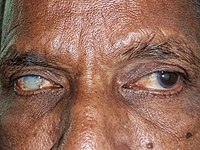
Photo from wikipedia
A 24-year-old woman presented with a 7-day history of blurry vision, redness, and extreme pain in her right eye. She had no pertinent medical or ocular history and did not… Click to show full abstract
A 24-year-old woman presented with a 7-day history of blurry vision, redness, and extreme pain in her right eye. She had no pertinent medical or ocular history and did not use spectacles or contacts. Uncorrected distance visual acuity (UDVA) was 20/40 in the right eye and could not be improved with refraction. Slitlamp examination revealed a 1.5 × 1.5 mm central epithelial defect with surrounding white blood cell recruitment. Confocal microscopy (Figure 1JOURNAL/jcrs/04.03/02158034-202304000-00020/figure1/v/2023-03-24T200747Z/r/image-tiff) was performed, and she was treated with chlorhexidine 0.02% drops every hour in the right eye. 2 weeks later, the cornea had completely re-epithelialized; however, persistent corneal haze, decreased visual acuity, and corneal thinning and flattening was noted. Pachymetry was 484 µm in the right eye and UDVA was 20/40 (Supplemental Figure 1, available at http://links.lww.com/JRS/A836). In the following 2 weeks, UDVA improved to 20/25. 6 months after the initial presentation, UDVA was unchanged and faint central corneal haze was noted on examination (Figure 2JOURNAL/jcrs/04.03/02158034-202304000-00020/figure2/v/2023-03-24T200747Z/r/image-tiff). Of interest, her family history is significant for her younger 16-year-old brother with 3 prior episodes of a similar type of keratitis/keratopathy over the course of 2 years in both eyes with similar central paracentral corneal haze, thinning, and flattening and similar confocal findings (Figure 3JOURNAL/jcrs/04.03/02158034-202304000-00020/figure3/v/2023-03-24T200747Z/r/image-tiff). He also was unresponsive to topical antibiotics and antivirals except topical chlorhexidine. Her brother has been our patient for the last several years prior to her first visit to our clinic. What is your diagnosis? What medical diagnostic tests, if any, would you recommend? Is this an infectious or simply an inflammatory response? Is there any genetic or familial predisposition?
Journal Title: Journal of cataract and refractive surgery
Year Published: 2023
Link to full text (if available)
Share on Social Media: Sign Up to like & get
recommendations!